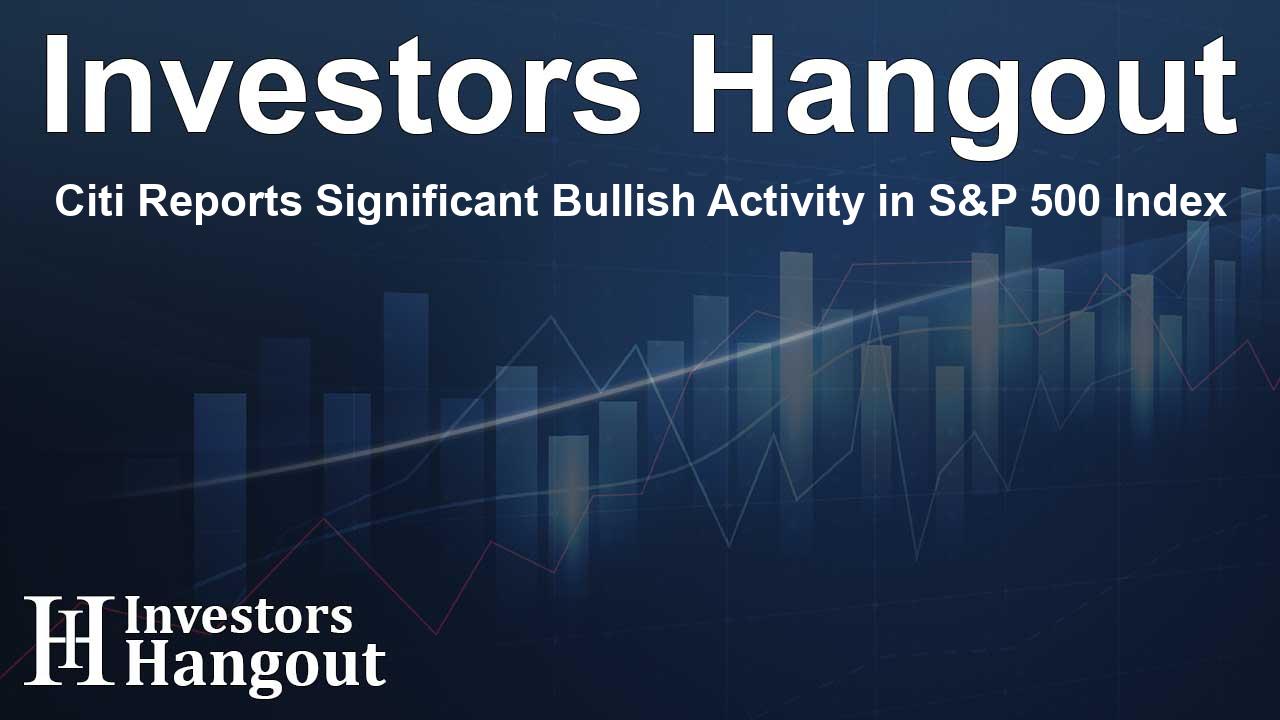Citi Reports Significant Bullish Activity in S&P 500 Index

Citi Reports Significant Bullish Activity in S&P 500 Index
Recent trends in the financial markets indicate a remarkable influx of investments into the S&P 500, as detailed in a report by Citi strategists. With almost $23 billion added in just one week, the S&P 500 is witnessing some of the strongest flows observed this year. This influx has driven bullish levels into the 98th percentile, signaling a robust investor confidence.
Understanding the Bullish Positioning
The latest data illustrates that the notional flows to the S&P 500 have surged to levels nearing a three-year peak. With positioning normalized to +4.2 out of 5, the S&P clearly stands out as the most bullish index among those tracked by Citi. This is a positive sign for many investors looking for growth opportunities within this benchmark index.
Nasdaq's Contrast
In stark contrast, the Nasdaq has only reached a mildly bullish position of +0.8, despite a recent uptick in risk flows. This depicts a different sentiment surrounding technology stocks compared to broader market indices. The Nasdaq, being known for its tech-heavy listings, shows signs that investor confidence is not keeping pace with that of the S&P 500.
Market Sentiment in European Indices
Across the Atlantic, investor activity in Europe has displayed a mixed response. While some fluctuations have occurred across various indexes, no significant directional shifts have been evident. The Eurostoxx has seen a slight uptick due to short covering amid new risk flows, whereas positioning in the DAX has also increased, establishing a cautiously optimistic perspective towards European markets.
General Outlook on Europe
Citi’s report reflects that the lack of clear directional shifts within European markets may well mirror the heightened uncertainty surrounding the economic future of the continent. This could suggest that while some investors are willing to take risks, many remain cautious, opting to maintain their positions without committing to strong bullish or bearish trends.
Chinese Markets: Volatility and Shifts
Chinese indexes have experienced notable volatility recently. Following new stimulus announcements, there has been a dramatic pivot from bearish to bullish positioning. However, the previous enthusiasm has somewhat dissipated, as evidenced by last week's trends within the FTSE China A50, where positions retracted, revealing a return towards a more neutral stance.
Profit-Taking Effect
The decline in bullish sentiment in Chinese markets can largely attributed to profit-taking among investors who were quick to capitalize on gains from the stimulus-induced rally. This indicates a market that is reactive to government interventions but also highlights a cautious approach among traders seeking to safeguard their profits.
Volatility and Short Positions
Despite fluctuations in market sentiment, short positions have remained significantly elevated, sitting above the 70th percentile. This presents a contrasting risk situation—while bullish movements are becoming pronounced in some areas, the sustained short positions imply that numerous investors are betting against a market rebound. The potential for a short squeeze is growing, as any abrupt upward movement could lead to considerable losses for these positions.
Hang Seng Stability
The Hang Seng Index continues to reflect a strongly extended position, suggesting stability amid the broader volatility that characterizes the current market landscape. Citi notes that this stability might provide a necessary counterbalance, presenting a nuanced understanding of investor behavior across these varied markets.
Frequently Asked Questions
What did Citi reveal about the S&P 500 flows?
Citi highlighted that nearly $23 billion in notional risk flows were added to the S&P 500, pushing bullish levels to the 98th percentile.
How does the S&P 500's positioning compare to the Nasdaq?
While the S&P 500 reached a bullish positioning of +4.2, the Nasdaq only managed +0.8, indicating a significant divergence in investor sentiment.
What has been happening in European markets according to Citi?
European positioning has been mixed with no clear directional shifts, reflecting uncertainty about the economic outlook within the region.
What changes occurred in Chinese markets after stimulus announcements?
After stimulus announcements, Chinese markets shifted from bearish to bullish but have since seen a reversal, leading to a more neutral position.
Are short positions increasing or decreasing in the current market?
Short positions remain elevated above the 70th percentile, indicating significant risk for a potential short squeeze as market volatility continues.
About The Author
Contact Ryan Hughes privately here. Or send an email with ATTN: Ryan Hughes as the subject to contact@investorshangout.com.
About Investors Hangout
Investors Hangout is a leading online stock forum for financial discussion and learning, offering a wide range of free tools and resources. It draws in traders of all levels, who exchange market knowledge, investigate trading tactics, and keep an eye on industry developments in real time. Featuring financial articles, stock message boards, quotes, charts, company profiles, and live news updates. Through cooperative learning and a wealth of informational resources, it helps users from novices creating their first portfolios to experts honing their techniques. Join Investors Hangout today: https://investorshangout.com/
The content of this article is based on factual, publicly available information and does not represent legal, financial, or investment advice. Investors Hangout does not offer financial advice, and the author is not a licensed financial advisor. Consult a qualified advisor before making any financial or investment decisions based on this article. This article should not be considered advice to purchase, sell, or hold any securities or other investments. If any of the material provided here is inaccurate, please contact us for corrections.
